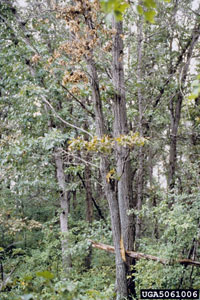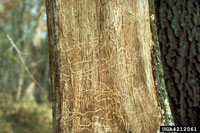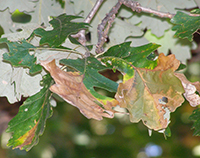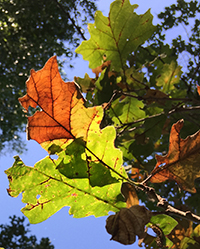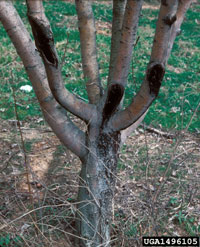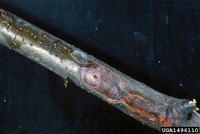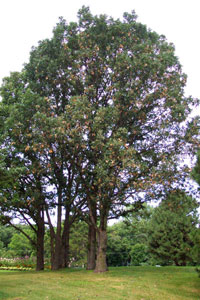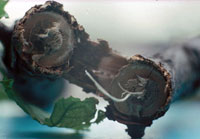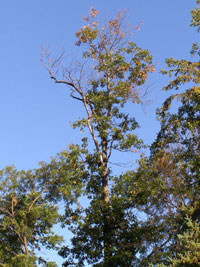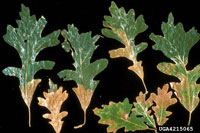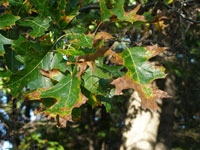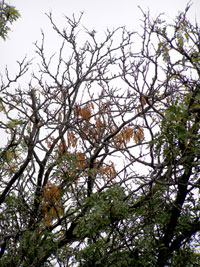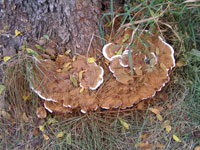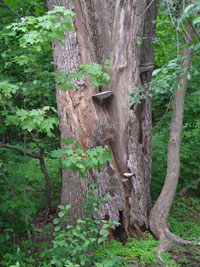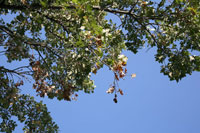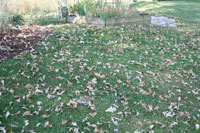Extension > Garden > Diagnose a problem > What's wrong with my plant? > Deciduous Trees > Oak > Leaves wilted and completely brown
Oak > Leaves > Leaves wilted and completely brown
1 of 7
Twolined chestnut borer
Agrilus bilineatus
- Leaves in upper canopy look wilted, turn brown but remain attached to branch for several weeks
- 1/8 inch D-shaped exit holes
- S-shaped galleries underneath bark
- Bluish black bodies with two light stripes running down the wing covers
- Larvae are approx. 1 inch long and white with 2 spines at abdomen tip
- Damage visible mid to late summer
- More information on twolined chestnut borer
2 of 7
Bur oak blight
Tubakia iowensis
- Infects only bur oaks - small acorn variety
- Spring and early summer, leaf veins on lower leaf surface have dark brown dots or short lines
- Mid-summer and fall, random lengths of leaf vein turn brown; some expand into brown wedge shaped areas on leaves
- Leaves may turn completely brown, some drop early
- Small raised black dots form on the petiole (stem) of infected leaves
- Some leaves remain attached through winter
- Symptoms appear in lower, inner canopy first. Disease progresses upward and outward over multiple seasons
- More information on Bur oak blight
3 of 7
Botryosphaeria canker
Botryosphaeria quercuum
- Leaves on random branch tips throughout the canopy wilt, turn brown and remain attached to twig
- Cankers with brown to black, sunken cracked bark can be found at the base of wilted twigs
- If bark is peeled back from the canker, brown streaks can be seen in the sapwood
- Small black raised pimple like fungal fruiting bodies can be seen scattered on infected twigs
- Cankers only occasionally extend into larger branches
- Damage easily confused with twig girdler damage
- More information on Botryosphaeria canker
4 of 7
Twig girdler
Oncideres cingulata
- Dead twigs may be scattered in canopy
- Small branches on ground; outer half is smooth while center is rough from where it has broken off
- Adult is about 9/16 inch long, grayish brown with scattered yellow spots, with antenna as long as its body
- Damage seen in August and September
- More information on Twig girdler
5 of 7
Oak wilt
Ceratocystis fagacearum
- Leaves wilt, leaf edges and tips turn brown, with a green center
- In red oak group symptoms are first seen in the top of the canopy, disease progresses to the entire canopy and kills tree in 1 to 3 months
- Infected trees drop their leaves
- In white oak group symptoms appear in one branch, disease progresses slowly from 1 to 5 years before death
- In white oak group - Peel back layer of bark on symptomatic branch to reveal brown streaking on wood
- Symptoms appear in whole groups of trees as infection spreads through root graft
- More information on Oak wilt
6 of 7
Ganoderma butt rot
Ganoderma applanatum
- Leaves are smaller in size and turn yellow earlier than normal
- Canopy appears thin with few leaves and multiple dead branches
- Fungal conks, a semicircle shelf fungi, can be found from the base of the tree up to 3 feet high on the trunk
- Conks are reddish brown and shiny on top, white and porous underneath, a rim of white may be visible on the edge of growing conks
- Infected wood at the base of the tree is white, soft, stringy or spongy
- Infected trees frequently break or fall over in storms
- More information on Ganoderma butt rot
7 of 7
Drought
- Leaf margins and branch extremities usually brown and wilt first
- Uniform wilting or browning of leaves throughout the tree
- Leaves often yellow (chlorotic)
- Severe drought stress may cause dieback of individual branches
- Drought-stressed trees and shrubs often drop their leaves abnormally early
- More information on watering trees and shrubs




